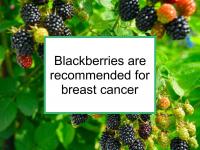Blackberries (Rubus fruticosus) are an excellent source of anthocyanins, especially cyanidin-3-glucoside, cyanidin-3-rutinoside, and cyanidin-3-xyloside. They are also a significant source of catechins, ellagic acid and enterolactone, and some dietary fiber, gallic acid, quercetin, salicylic acid and vitamin C. The combination of chemicals in blackberries may more effectively prevent cancer than any one of them alone.
Breast cancer-related effects of eating blackberries
Few studies have been performed that directly address the effects of consuming blackberries on breast cancer. Therefore, evidence that blackberries have chemopreventive properties is derived mainly from studies of related berries.
Blackberry compounds can increase treatment effectiveness
Blackberry anthocyanin cyandin-3-glucoside has been shown to enhance the treatment effects of trastuzumab (Herceptin) in HER2+ breast cancer cells.
Enterolactone has been found to increase the sensitivity of breast cancer cells to radiation, thereby potentially enhancing the treatment effects of radiotherapy.
Gallic acid has been shown to increase the effectiveness of paclitaxel chemotherapy in hormone receptor positive (ER+/PR+) breast cancer cells.
Ellagic acid has been reported to increase the sensitivity of ER+/PR+ breast cancer cells to radiation while reducing damage to normal cells, thereby potentially enhancing the treatment effects of radiotherapy. Ellagic acid has also been shown to reduce doxorubicin-induced neurotoxicity and cardiomyopathy. In addition, pretreatment with ellagic acid has been shown to sensitize cancer stem cells to cisplatin treatment by increasing DNA damage and impairing the DNA repair mechanism of the cancer stem cells.
Anthocyanins
Berry anthocyanins have been shown to inhibit breast cancer proliferation, inflammation and angiogenesis (the formation of new blood vessels). In addition, fruit anthocyanins such as cyanidin-3-glucoside have been demonstrated to heighten the efficacy of the chemotherapy drug cisplatin. Cyandin-3-glucoside has also been shown to reduce HER2+ cell proliferation and interfere with the viability and metastatic potential of triple negative (ER-/PR-/HER2-) breast cancer cells.
Ellagic acid
Ellagic acid has been shown to reduce proliferation of ER+/PR+ breast cancer cells. Ellagic acid has also been found to be effective in the prevention of estrogen-induced mammary tumors in rats. In fact, ellagic acid has been shown to inhibit breast cancer development in a variety of cell and animal studies, in part by inhibiting angiogenesis, the growth of new blood vessels. Angiogenesis is a crucial step that separates preinvasive and dormant forms of cancer from invasive and metastatic malignant growth.
Enterolactone
Blackberry seeds contain relatively high levels of phytoestrogens (in the form of lignans such as enterolactane) compared to the seeds of other berries. In fact, blackberry seeds are an excellent source of beneficial nutrients and should be eaten along with the flesh, if possible.
Consumption of blackberries results in the production of enterolactone by intestinal microflora. This production is influenced by the characteristics of other foods ingested at the same time. High levels of enterolactone in the blood have been found to be associated with decreased risk of breast cancer in most relevant studies. However, note that blackberries are not an estrogenic food overall.
Postmenopausal women with breast cancer and a high intake of plant lignans such as enterolactone have been found to be less likely to die from their breast cancer than those with a low intake.
Additional comments
Marionberries are a type of blackberry (a cultivar cross between Chehalem blackberries and Olallie blackberries). Loganberries are a hybrid cross between between a blackberry and a raspberry.
Non-organic blackberries and related berries must be washed very thoroughly to remove pesticide residue as much as possible.
Sources of information provided in this webpage
The information above, which is updated continually as new research becomes available, has been developed based solely on the results of academic studies. Clicking on any of the underlined terms will take you to its tag or webpage, which contain more extensive information.
Below are links to 20 recent studies concerning this food and its components. For a more complete list of studies, please click on blackberry.
